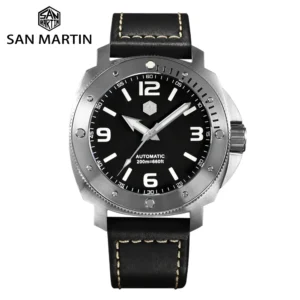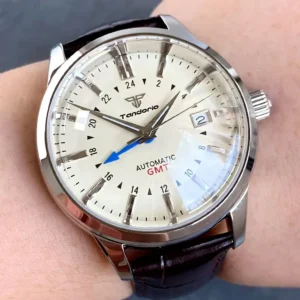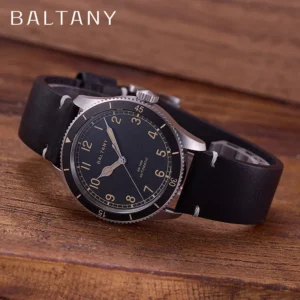Introduction: The Enduring Allure of Bronze in Horology
In the world of fine watchmaking, few materials capture the imagination quite like bronze. This distinctive copper-tin alloy has experienced a remarkable resurgence in modern horology, becoming a favorite among enthusiasts who appreciate watches with character and personality. Unlike stainless steel or titanium timepieces that remain relatively unchanged through years of wear, bronze watches evolve and develop a unique patina – a living testament to the experiences of their owner.
What makes bronze truly special is its ability to tell a story. A new bronze watch glows with a warm, golden hue reminiscent of precious metals. However, with time and exposure to the elements, each watch develops its own personality – subtle darkening around edges, mottled patterns across surfaces, and rich color variations that can range from chocolate browns to greenish tints.
This unique characteristic connects perfectly with bronze’s maritime heritage. For centuries, bronze has been the material of choice for maritime equipment, prized for its exceptional corrosion resistance to saltwater. This historical connection makes bronze a natural choice for dive watches, connecting modern timepieces to generations of seafaring tradition.
In this comprehensive guide, we’ll explore everything you need to know about bronze as a watch case material – from its composition and properties to patina development, maintenance, and how it compares to other materials.
Understanding Bronze: The Material Science
At its core, bronze is primarily an alloy of copper and tin, though other elements can be added to create different varieties with specific properties. In watchmaking, several specific bronze alloys have become favorites among manufacturers for their unique characteristics.
Common Bronze Alloys in Watchmaking
CuSn8 (Phosphor Bronze): Consisting of approximately 92% copper and 8% tin, this is perhaps the most widely used bronze alloy in watchmaking. It offers excellent corrosion resistance and develops a rich, dark patina over time. The small amount of phosphorus helps improve its strength and flowing properties during casting.
Aluminum Bronze: Contains aluminum instead of tin (typically 92% copper, 8% aluminum), resulting in a slightly lighter color when new. This alloy develops a more subtle patina and tends to darken less dramatically than traditional tin bronzes.
Other Variations: Some watchmakers experiment with custom bronze alloys, adding elements like manganese, nickel, or silicon to achieve specific properties or distinctive patina development.
It’s important to distinguish bronze from brass, another copper alloy that’s sometimes confused with bronze. While bronze primarily combines copper with tin, brass mixes copper with zinc, resulting in a different color and patination behavior.
Key Properties of Bronze Watch Cases
- Corrosion Resistance: Exceptionally resistant to saltwater corrosion
- Antimicrobial: Naturally inhibits bacterial growth
- Antimagnetic: Non-magnetic properties make it ideal for precision timepieces
- Density: Heavier than titanium but similar to stainless steel (approximately 8.77 g/cm³)
- Hardness: Typically softer than stainless steel but can be hardened through work-hardening
- Thermal Conductivity: Excellent heat dissipation
These properties make bronze particularly well-suited for dive watch engineering where durability, corrosion resistance, and heritage aesthetics are prized. The material’s warmth and unique evolution have made bronze automatic watches increasingly sought-after by collectors and enthusiasts who appreciate timepieces with distinctive character.
The bronze case oxidation process is what gives these timepieces their unique appeal, as the material reacts with environmental elements to create a protective surface layer that tells the story of the watch’s journey with its wearer.
The Soul of Bronze: Understanding Patina
The most distinctive feature of bronze watches is undoubtedly their ability to develop patina. But what exactly is patina, and what makes it so special?
Patina refers to the natural oxidation layer that forms on the surface of bronze when exposed to air, moisture, and other environmental elements. This isn’t a defect but rather a desirable characteristic that protects the metal underneath while creating a unique aesthetic signature. The process involves copper molecules on the surface reacting with oxygen, carbon dioxide, and moisture to form various copper compounds – primarily copper oxide, copper carbonate, and sometimes copper chloride.
What makes this process magical for watch enthusiasts is that no two bronze watches will age exactly the same way. Your personal body chemistry, environmental conditions, and how you use your watch all influence patina development:
- Skin chemistry: Oils and acids from your skin accelerate and alter patina development
- Environment: Humidity levels, saltwater exposure, and air quality affect oxidation rates
- Usage patterns: A watch worn daily develops differently than one worn occasionally
- Storage conditions: How and where you store your watch influences patina when not worn
The patina process transforms the original bright, golden appearance of new bronze into a spectrum of colors ranging from warm browns and rusty oranges to deep chocolates and occasionally greenish tints. Different bronze alloys follow distinct patination paths – CuSn8 tends toward darker, more dramatic patinas, while aluminum bronze often develops subtler, more uniform aging.
This natural evolution doesn’t just change appearance; it creates a protective barrier that helps shield the underlying metal from further corrosion. The patina essentially sacrifices itself to preserve what lies beneath, making bronze remarkably durable despite its active surface.
The formation process of bronze watch patina is fascinating from both aesthetic and metallurgical perspectives. Various factors influence the bronze watch patina development timeline, from environmental conditions to the specific alloy used by the manufacturer.
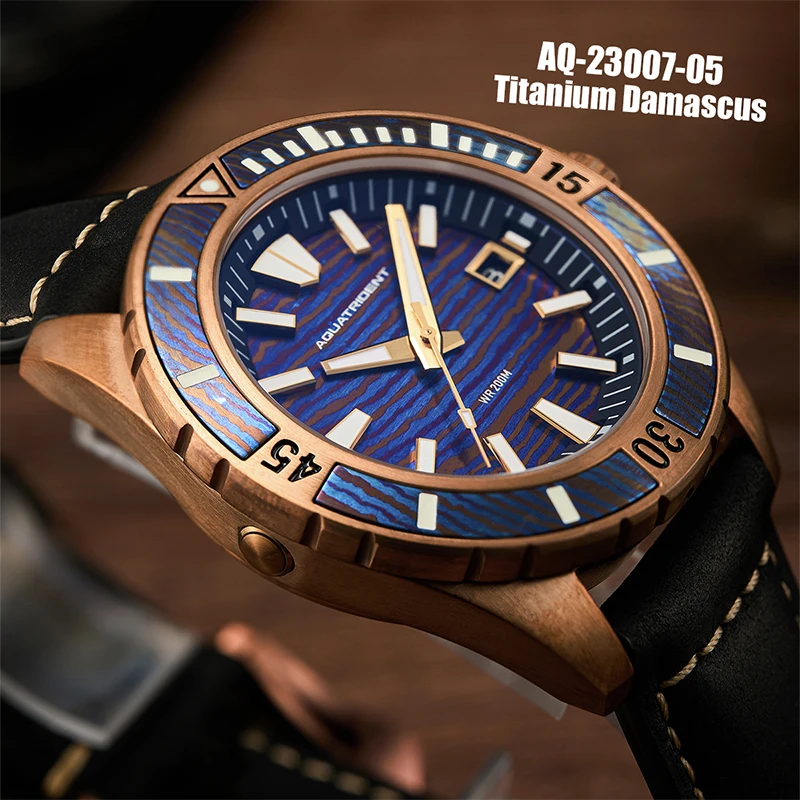
Living with Bronze: Care and Maintenance
One of the most appealing aspects of owning a bronze watch is embracing its ever-changing nature. Many enthusiasts cherish the gradual evolution of their timepiece, considering the developing patina as a record of adventures and experiences. That said, there are times when you might want to influence this process – either slowing it down or occasionally resetting it.
Embracing or Managing Patina Development
If you prefer to slow down patination and keep your bronze watch looking newer for longer:
- Wipe the case with a soft, dry cloth after wearing to remove moisture and skin oils
- Store your watch in a low-humidity environment when not in use
- Consider using watch cases with anti-tarnish strips that absorb corrosive elements
- Some owners apply a thin coat of renaissance wax or similar protective products (though this will need periodic reapplication)
Cleaning and Removing Patina
There may come a time when you want to remove accumulated patina and refresh your bronze watch. Here’s a gentle method that works for most bronze watches:
- Prepare the watch: Remove the strap if possible and ensure the crown is securely screwed down
- Create a mild cleaning solution: Mix equal parts lemon juice and baking soda into a paste
- Apply carefully: Using a soft toothbrush or cloth, gently apply the paste to the bronze surfaces only
- Gentle scrubbing: Work in small circular motions, avoiding contact with non-bronze parts
- Rinse thoroughly: Rinse with clean water, ensuring no cleaning solution remains
- Dry completely: Pat dry with a soft cloth and allow to air dry fully before wearing
Caution: Never submerge the entire watch unless it’s designed for full water exposure. Always protect the crown, caseback gaskets, and crystal during cleaning.
For more aggressive patina removal, commercial products like Brasso can be used with extreme caution, though these should generally be avoided unless you’re comfortable with the risks.
Advanced Patina Techniques
Some enthusiasts enjoy accelerating or customizing their watch’s patina. Common methods include:
- Egg sulfur method: Placing the watch (not touching) near hard-boiled egg yolks in a sealed container
- Salt spray method: Creating a fine mist of saltwater and lightly applying it to the case
- Ammonia vapor: Exposing the watch to ammonia fumes (requires proper ventilation and safety precautions)
These methods should be approached with caution, as they can cause uneven results or potentially damage your timepiece if not done carefully.
For more detailed information, our comprehensive bronze watch care guide provides additional techniques and precautions. Many professional-spec dive watches are designed to handle various environmental conditions that can affect patina development.
Pros and Cons of Bronze Watch Cases
Before investing in a bronze timepiece, it’s worth considering the advantages and potential drawbacks of this distinctive material:
Advantages
- Unique Individuality: Each bronze watch develops a one-of-a-kind appearance based on the owner’s lifestyle and environment
- Rich, Warm Aesthetic: Bronze offers a distinctive golden-reddish hue that stands apart from common stainless steel
- Heritage Connection: The material carries historical significance, particularly for maritime and diving enthusiasts
- Excellent Durability: Bronze is remarkably tough and resistant to impacts
- Superior Corrosion Resistance: Particularly in saltwater environments, making it ideal for marine use
- Storytelling Element: Your watch becomes a record of experiences and adventures through its changing appearance
Disadvantages
- Evolving Appearance: The changing patina may not appeal to those who prefer their watch to look consistently new
- Potential Skin Discoloration: Some wearers may experience temporary greenish marks on skin, though most modern bronze watches use non-bronze casebacks to prevent this
- Weight Considerations: Bronze is typically 10-15% heavier than stainless steel of the same volume
- Softness: More prone to scratching than hardened stainless steel or ceramic
- Maintenance Requirements: May require occasional cleaning if patina becomes excessive
- Price Premium: Bronze watches often command higher prices than their stainless steel counterparts
The history of bronze in watchmaking reveals fascinating connections to traditional maritime instruments, as detailed in our timeline of diving watch innovations. This historical context helps explain why many enthusiasts are drawn to the material despite some of its practical challenges.
Bronze vs. Other Watch Case Materials
Understanding how bronze compares to other popular watch case materials can help determine if it’s the right choice for your collection.
Bronze vs. Stainless Steel
| Characteristic | Bronze | Stainless Steel |
|---|---|---|
| Weight | Slightly heavier (8.8 g/cm³) | Standard benchmark (7.9-8.0 g/cm³) |
| Appearance | Warm golden hue that changes over time | Consistent silver appearance with minimal change |
| Scratch Resistance | Moderate; shows scratches but they often blend with patina | Good; maintains appearance longer |
| Corrosion Resistance | Excellent in saltwater; forms protective patina | Excellent overall; stays unchanged |
| Maintenance | May require occasional cleaning or patina management | Minimal; simple cleaning maintains appearance |
| Hypoallergenic | Less likely to be hypoallergenic | Usually hypoallergenic (especially 316L grade) |
Bronze vs. Titanium
| Characteristic | Bronze | Titanium |
|---|---|---|
| Weight | Substantially heavier (8.8 g/cm³) | Approximately 40% lighter (4.5 g/cm³) |
| Appearance | Warm with evolving patina | Cool gray tone that remains stable |
| Scratch Resistance | Moderate | Variable (grade-dependent); can show scratches easily |
| Comfort | Can feel heavy on smaller wrists | Exceptionally comfortable due to lightweight |
| Thermal Properties | Conducts heat away from skin | Low thermal conductivity; doesn’t feel cold |
| Hypoallergenic | Not typically | Excellent; virtually no allergic reactions |
Bronze vs. Precious Metals
| Characteristic | Bronze | Gold/Platinum |
|---|---|---|
| Initial Appearance | Warm, golden-reddish tone | Distinctive colors specific to each metal |
| Aging Characteristics | Develops patina and darkens | Maintains luster with proper care |
| Value Retention | Minimal material value appreciation | Potential investment value beyond the watch itself |
| Durability | Very good for daily wear | Gold is softer unless alloyed; platinum is durable but scratches |
| Prestige Factor | Growing appreciation among enthusiasts | Traditional luxury status symbols |
Our definitive watch case thickness comparison provides additional insights into how different materials affect the overall wearing experience. For those considering alternatives, titanium automatic watches offer exceptional lightness and comfort compared to bronze.
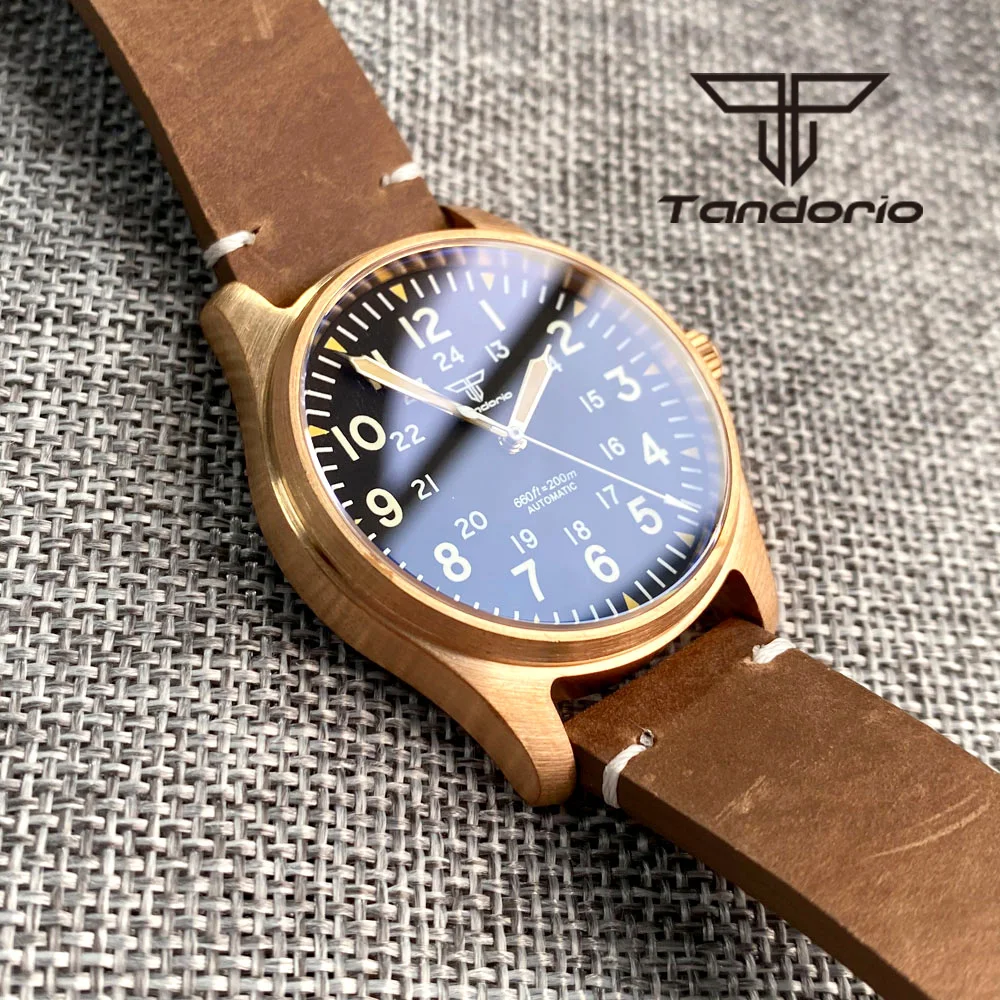
Notable Watch Brands Featuring Bronze Cases
The bronze watch renaissance has inspired many prestigious watchmakers to incorporate this distinctive material into their collections. While specific models change over time, several brands have become particularly associated with bronze timepieces:
Many traditional Swiss manufacturers have embraced bronze, often using it for heritage-inspired dive watches and marine chronometers. These watches typically feature traditional bronze alloys that develop pronounced patina, emphasizing the connection to naval heritage.
Italian and German watchmakers have also made significant contributions to bronze watchmaking, often experimenting with case designs that maximize the material’s unique aesthetic properties. Some use proprietary alloys that develop more controlled or distinctive patina patterns.
Boutique manufacturers from across Europe and North America have created innovative bronze timepieces, sometimes utilizing custom alloys or unique finishing techniques that influence how patina develops. These smaller brands often push boundaries with creative designs that showcase bronze’s unique properties.
Japanese watchmakers have incorporated bronze into both affordable and luxury timepieces, often focusing on excellent value propositions that bring this distinctive material to more accessible price points.
Bronze cases appear most frequently in several watch categories:
- Dive watches, where the maritime connection feels most authentic
- Field and military-inspired watches, where the rugged, evolving aesthetic fits the intended use
- Vintage-inspired designs that leverage bronze’s warmth and character
- Aviation/pilot watches, where bronze recalls the golden age of flight
The automatic field military watches category showcases many excellent bronze options that highlight the material’s rugged, evolving character.
Military Inspired Automatic Watches, Rugged Automatic Watches, Tactical Automatic Watches
Price range: $852.14 through $994.60 Select options This product has multiple variants. The options may be chosen on the product pageAutomatic Chronograph Watches, Classic Style Dive Watches
$3,053.06 Select options This product has multiple variants. The options may be chosen on the product pageBronze Automatic Watches, Military Inspired Automatic Watches, Professional Spec Dive Watches
Price range: $1,442.21 through $1,442.82 Select options This product has multiple variants. The options may be chosen on the product pageProfessional Spec Dive Watches, Titanium Automatic Watches
$574.74 Select options This product has multiple variants. The options may be chosen on the product pageClassic Automatic Dress Watches, GMT Automatic Watches, GMT Dive Watches
Price range: $468.93 through $552.94 Select options This product has multiple variants. The options may be chosen on the product pageClassic Pilot Watches, Military Inspired Automatic Watches
$561.00 Select options This product has multiple variants. The options may be chosen on the product page
Is a Bronze Watch Right For You?
Deciding whether a bronze timepiece belongs in your collection requires honest assessment of your preferences and lifestyle. Consider these key questions:
Do you appreciate evolution and character in your possessions?
Bronze watches continuously change and develop unique characteristics. If you enjoy items that tell a story and reflect their journey, bronze offers unmatched character. However, if you prefer items that maintain a consistent, pristine appearance, the ever-changing nature of bronze might prove frustrating.
What’s your wearing pattern and environment?
Bronze watches develop more pronounced patina with frequent wear, especially in humid environments or near saltwater. If you live near the coast or enjoy swimming, your bronze watch will develop patina more quickly. Conversely, in dry climates with occasional wear, patina will develop more slowly and subtly.
How do you feel about maintenance?
While bronze watches don’t require constant attention, they do benefit from occasional cleaning if the patina becomes excessive. Are you comfortable with this minimal maintenance, or would you prefer a more “set and forget” material like stainless steel?
Does the aesthetic appeal to you?
Bronze offers a distinctive warm hue unlike any other watch material. Its vintage character and developing patina create an appearance that’s both nostalgic and unique. This aesthetic works particularly well with leather straps and heritage-inspired designs.
What’s your budget consideration?
Bronze watches typically command a price premium over comparable stainless steel models but cost significantly less than precious metal alternatives. They offer a distinctive luxury option at a more accessible price point than gold or platinum.
The journey of how bronze watches age naturally can be fascinating to observe, creating a personal connection between timepiece and owner that few other materials can match.
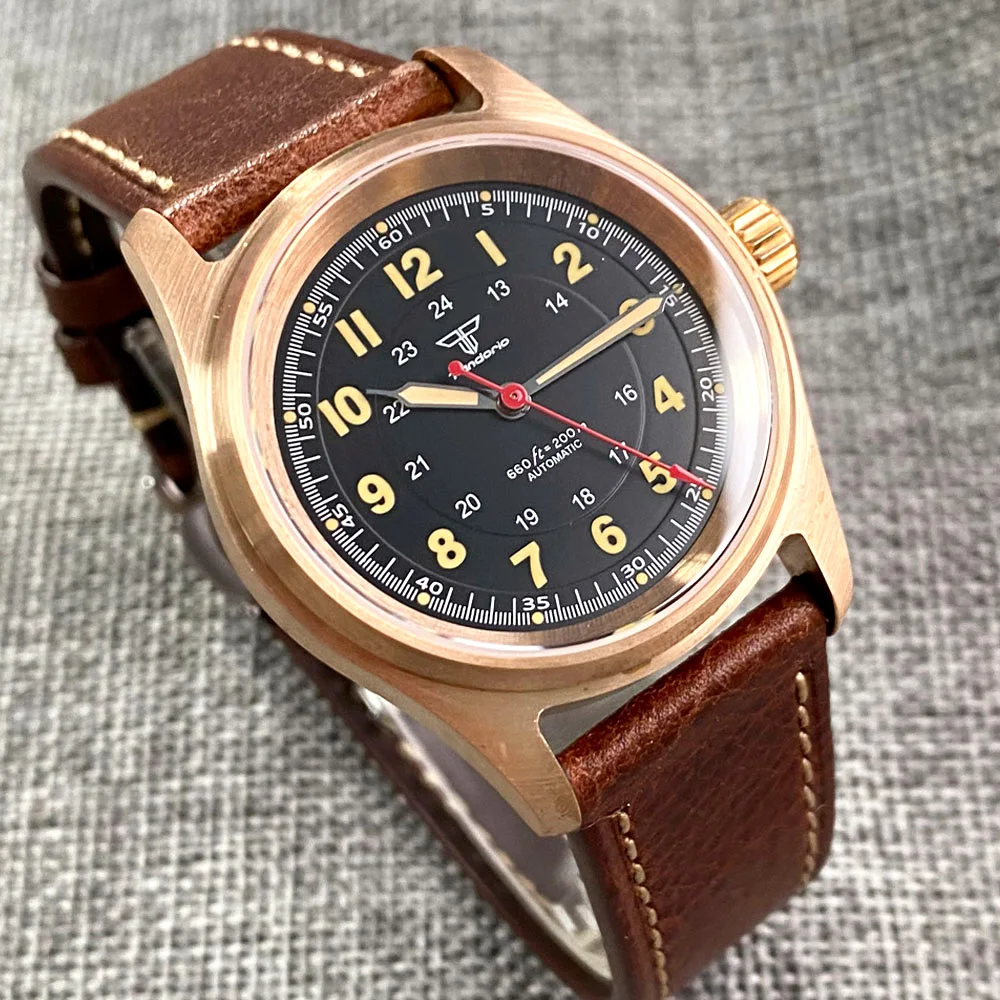
Conclusion: The Timeless Appeal of an Ever-Changing Material
Bronze occupies a special position in the watchmaking world – a material with ancient origins that continues to captivate modern enthusiasts. Its appeal lies precisely in its impermanence, in the way it changes and evolves with its wearer. Unlike the pristine perfection of steel or the unchanging luxury of precious metals, bronze tells a story – your story.
The journey of owning a bronze watch offers something increasingly rare in our disposable age: a personal connection to an object that evolves alongside you. Each scratch, each darkened edge, each subtle color variation represents moments lived and experiences gained.
For the watch collector seeking something beyond the commonplace, bronze offers a compelling blend of distinctive aesthetics, practical durability, and personal connection. While it may require occasional maintenance and won’t appeal to everyone’s tastes, those who embrace bronze often develop a special appreciation for its unique character.
As you consider adding a bronze timepiece to your collection, remember that you’re not just purchasing a watch – you’re beginning a relationship with a living material that will accompany you through life’s adventures, changing and developing character with each passing day.
The broader evolution of dive watch technology reveals how bronze has maintained its relevance through centuries of innovation, continuing to offer qualities that modern materials can’t replicate.
Frequently Asked Questions (FAQ)
Will a bronze watch turn my wrist green?
Modern bronze watches typically feature stainless steel or titanium casebacks that prevent direct contact between bronze and skin. This design minimizes the risk of skin discoloration. However, some wearers may still experience occasional green marks, especially in hot weather or during extended wear. These marks wash off easily and are harmless.
How long does it take for bronze to develop patina?
The patina development timeline varies dramatically based on environmental conditions, wearing patterns, and the specific bronze alloy. Initial color changes may appear within days in humid environments or near saltwater, while more significant patina might develop over weeks or months. Some watches develop rich patina in just 2-3 months of regular wear.
Can patina be completely removed?
Yes, patina can be removed using mild acidic solutions like lemon juice with baking soda, returning the bronze to a state closer to its original appearance. However, complete restoration to factory-new condition is challenging without professional refinishing.
Is bronze heavier than steel?
Bronze is approximately 10-15% heavier than stainless steel for the same volume. A typical bronze dive watch might weigh about 30-40% more than its titanium counterpart but only slightly more than the same watch in steel.
Are bronze watches durable?
Bronze watches are exceptionally durable. The material is resistant to impacts and the patina layer actually protects against deeper corrosion. While bronze can scratch more easily than hardened steel, these marks often blend with the developing patina, becoming part of the watch’s character rather than detracting from it.
What is the best bronze alloy for watches?
There is no single “best” bronze alloy, as each offers different characteristics. CuSn8 (with approximately 8% tin) is widely used for its excellent patina development and corrosion resistance. Aluminum bronze maintains a brighter appearance longer. Your preference for patina development speed and color should guide your alloy choice.


